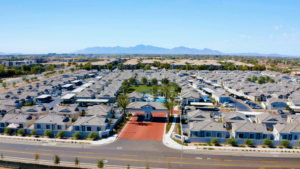Phoenix’s economic growth has catapulted us to become one of the country’s largest and most dynamic cities. This emerging recognition on the national stage has both prompted inventive developments and revitalized our assets as a result of the innovative efforts of our business and municipal teams. As real estate professionals, we are not only here to support this Phoenix revitalization and renaissance, but we have the vision, fortitude and capabilities to execute on additional enhancements that benefit responsible growth of the community.
LEARN MORE: Tempe’s historic Hayden Flour Mill redevelopment could begin this year
My decades of experience in the Greater Phoenix commercial real estate industry have shaped my unique perspective with wisdom and hometown pride, along with an understanding of how this impacts Phoenix’s economy and its left-behind assets, large and small. In each assignment, I especially enjoy promoting the long-term value proposition of investing in Greater Phoenix.
Some of Greater Phoenix’s landmark projects of the last century are being re-imagined for a new age. Languishing regional malls, mothballed defense manufacturing facilities and under-utilized university property all have been targeted with a progressive vision.

One of the community’s greatest examples is the 760,000 square foot Flite project in Goodyear. This 23-acre facility located adjacent to Goodyear Airport holds roots in manufacturing B-24 Bombers during World War II. Daryl Burton of Reliance Management envisioned a future for this property that would fuel our progress. He masterfully preserved the best elements and ambiance of this aviation landmark while creating a modern, flex space to suit today’s users. It’s incredible to think that 80 years ago this site was making history with innovative blimp creation and today it is occupied by Unmanned Vehicle Technology, a drone training company.
While Flite transformed a historic facility, frequently redevelopment is motivated by a push to bring a “higher and better use” to increasingly more valuable land. Novus Innovation Corridor in Tempe re-purposed underutilized land near Arizona State University. The site was being used for fraternity housing and a golf course. The university’s expansion and Tempe’s surge in corporate popularity encouraged a more dense and economically fruitful use of the land. The 355-acre mixed-use campus is on its way to becoming home to cutting-edge corporate and medical office buildings, a senior housing community, luxury apartments, hotels, dining and shopping. This is all located within walking distance of ASU and Tempe Town Lake, supporting the live-work-play, pedestrian-focused lifestyle of the 21st Century.
Shifts in the way we function as a society often are the catalyst for redeveloping antiquated projects. Nowhere is that truer than in the regional mall category of commercial real estate. Large department stores and many massive indoor malls are no longer well-leased or supported by consumer buying habits. This has left an abundance of these sizable structures floundering in primarily suburban areas of America. Vibrant communities, such as Greater Phoenix, maintain a strong enough population base and socioeconomic consumer market to encourage creative redevelopment of these malls. We initially experienced it with the Los Arcos Mall transition to SkySong, a 1.2 million square foot mixed-use project. This trend moved to Park Central Mall on Central Avenue and MetroCenter in West Phoenix. Currently, RED Development is thoroughly recreating Paradise Valley Mall and plans are well underway for the renaissance of Fiesta Mall in Mesa.
Fiesta Mall, which opened in 1979, was the mecca of retail shopping for the East Valley until it closed in 2018. Developers began demolishing the 1.2-million-square-foot, antiquated structure in July of 2023, preparing to create a reimagined community focus on the 80-acre site. The developer, Verde Investments, envisions a mixed-use property with individual elements being determined based on market demand. The site has even been floated as a possible relocation option for the Arizona Coyotes ice hockey team. The key to these successful regional mall redevelopments involves keeping a keen eye on market demand and using creativity surrounding consumer experience to formulate a plan that is viable for financing and investment.
Successful redevelopment and repurposing of commercial properties require more than the asset transformation. These endeavors require an evolution of the community itself. Countless towns and cities across the U.S. contain vacant manufacturing facilities and half-leased malls. But many of these places do not have a vibrant enough population or business environment to attract the quality developers and financing to rejuvenate these assets.
Greater Phoenix is poised for remarkable transformation because we have become one of the nation’s most appealing cities for business growth and in-migration. Our metro area welcomes an average of 210 new residents a day and our private wages have increased 18% since 2019. As a result of business growth and relocations to Arizona since 2018, our economy now boasts an amazing diversity of industries. Rather than ascribe to a “build it and they will come” philosophy, we in Phoenix are now in a position where the people have come and keep coming, creating desire and support for these vibrant, modern projects.
As our community evolves and comes of age on the national stage, we will benefit from the most contemporary and highest quality of commercial planning. These redeveloped and repurposed projects will rise from their former uses, beautifying our neighborhoods and providing a focal point for our ever-changing modern lifestyle.
Beyond the aesthetic and life advantages of these projects, Greater Phoenix will reap the financial rewards of this investment. The population and job growth of our city has attracted the attention of investors throughout the country. Each new, successful project elevates the perceived and actual value of our community and makes economic sense to its investors. Flite Goodyear was a contrarian purchase at $35 per square foot in 2006, and today is easily valued at a 6x multiple or more. The Grove project on 44th Street and Camelback Road, which is nearing completion, took an obsolete garden office campus with subterranean space and transformed it into one of the city’s leading mixed-use projects. Purchased for $693 per square foot, the newly finished medical office building that is fully occupied by Banner set a record price earlier this year; while tenants in the general office building are paying the highest rates in the Metro Area.
As commercial real estate professionals and residents, we are fortunate to be located here, in Greater Phoenix, where our community is strong, and continues to thrive. This consistent growth propels our talented developers and investors to innovate and create places that attract new residents, businesses, and visitors, assuring that we will ascend even further on the national scale of best cities.
Author: Mindy Korth is executive vice president of Colliers in Arizona.




